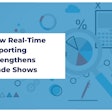
Trying to navigate the industry's new normal? BizBash is here to help. Every week, we'll be tackling your questions on the nitty-gritty details of events. Submit questions on BizBash's Instagram, Twitter, Facebook, or LinkedIn pages, or email us at [email protected].
As event planners have quickly learned, the rules of attendee engagement have changed in the age of virtual events. But how does that apply to the length of virtual events and educational sessions? How long is too long for a single day?
To answer this, BizBash reached out to Alex Plaxen, the Washington, D.C.-based vice president of experience strategy for Nifty Method Marketing & Events. "Even without a quarantine, a virtual event should be run differently than an in-person event—and that includes length," Plaxen advises. "Think of all the time you spend at an event getting people settled into their seats, warming up the crowd, walking through the halls, networking, etcetera. It's important to pad your event agenda in-person to give people that time. However, you don't need that for a virtual event."
Plaxen believes that unless your content is interactive, you may lose your audience's attention span in just 15 or 20 minutes. "Cut back your content. No more 60-minute breakouts. No eight-hour-long days," he suggests, adding that planners should consider four- to six-hourlong events with 15- to 20-minute sessions, plus plenty of breaks for networking and other interaction. "Take advantage of the format, and provide supplemental content outside of the event—like downloadable videos your audience can binge-watch, or worksheets they can download."
Related: 10 Smart Tips for Keeping Attendees Engaged Before, During, and After a Virtual Event
To test Plaxen's theory, I posted an informal poll on my personal LinkedIn page on Monday and ended up getting 194 responses in just three days. The overwhelming majority of respondents—133, or 69 percent—in this highly unscientific poll said that virtual events shouldn't last more than "two to four hours per day." Meanwhile, 56 people, or 28 percent of respondents, voted for "no more than one hour per day," while just five people, or 3 percent, were OK with "five hours or more per day."
Several of my LinkedIn connections expanded on their votes in the poll's comment section: "In recent years, attendee attention spans have been shrinking, and moving events online has only amplified this trend," wrote Allison Pieter, founder and president of Cassis Productions in Los Angeles. "Previously, we were only competing with emails, phone calls, exhibitors, in-person networking, and the comfy bed at the hotel. Most of those distractions still exist in a virtual format; now, there are also kids, partners, cooking, cleaning, laundry, as well a host of unrelated online distractions a computer click away. The best way to avoid the Alt + Tab effect is to create short, engaging, frequently interactive content—no more than half the time frame of your in-person gathering."
Meanwhile, Taylor Buonocore-Guthrie, the New Jersey-based co-creator of Convers(ate), voted for the "five hours or more per day" option. "Most of us take a break during in-person conferences and aren't likely to attend every single session (or devote full attention to every single session even if we're sitting in all of them)," she commented. "So I like the option of a full-day agenda where I can pop in and out."
But of course, added Los Angeles-based projection designer Bart Kresa, "[It] all depends on the quality of the experience you provide. If you throw in some lunch and dinner and a glass of wine..." We'll let you finish that sentence!
Further Reading: Explore BizBash's coverage of all-things virtual



















